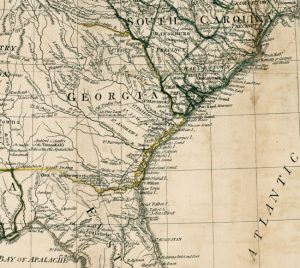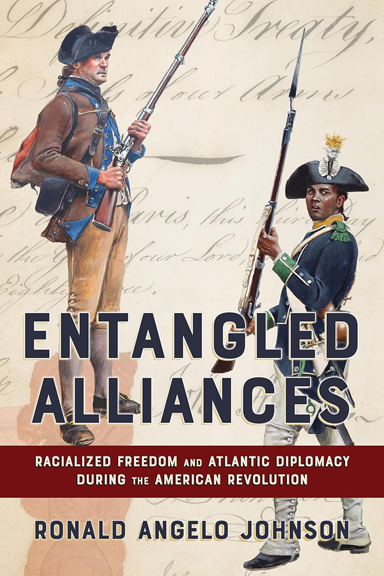By 1773, Creek Indians in Georgia had run up debts with traders far larger than any amount they could pay. The colony pressed the issue on behalf of its traders and worked out a land deal whereby the Creeks made a large tract of land west of Augusta available for settlement. In return, the colony would sell the land and pay off their own accumulated debts with part of the proceeds. Land sales early in 1774 not only attracted settlers from North Carolina and other parts of the colonies but also drew the attention of a certain young man from Scotland named Thomas Brown.
Born into a family with military tradition but little property, 24 year old Thomas eagerly answered the call to sponsor a ship full of immigrants to the backcountry of Georgia. Working with Governor Wright, Brown arranged to bring several shiploads of potential settlers to the new territory in return for rights to some 5600 acres of land in twelve tracts on both sides of the Little River. Brown would eventually land almost 300 people from Scotland and the Orkney Islands. His ship, the Marlborough, first arrived in Savannah sometime in October 1774 and Brown settled his people on a tract of land below the river. Indian raids had plagued the new lands all year; many within the tribes resented the sale and started a pattern of murdering settlers and pillaging outlying homes.[1]
Thomas Brown put his energy into the settlement he called, Brownsborough. Soon a known and respected member of the Augusta community, Brown dispatched the Marlborough back to Scotland for another group of colonists. Governor Wright called him “a young Gentleman” of the “better sort” and appointed Thomas to the office of magistrate.[2] Unfortunately, the run-up to revolution was in full swing and the politics of colonial Georgia turned to talk of rebellion. The 1st Continental Congress voted for non-importation, non-exportation agreements throughout the colonies and Sons of Liberty soon began to press their cause in Savannah.

The situation remained quite different in the backcountry. The Sons of Liberty found recruiting difficult as people in the cession lands continued to fear Indian depredations and viewed the Crown as their potential protector. While the Continental Congress was aligning itself for a dispute with Britain, the people of St. Paul’s Parish near Augusta reacted with petitions declaring “our dissent to all resolutions by which his Majesty’s favour and protection might be forfeited.” The signers included many who would later prove to be very stalwart Patriots including Elijah Clark, John Dooly, William Few, and William Candler.[3]
Patriots assumed control of state governments across the colonies during the early months of 1775 and Georgia and South Carolina were certainly no exception. As President of South Carolina’s infamous Secret Committee, William Drayton devised a plan whereby they accused the British Indian Agent, John Stuart, of plotting to have the Cherokee conduct extensive raids along the frontier in an attempt to put down rebellion in the colony. Stuart reacted to the allegation by fleeing to Savannah where he needed to arrange distribution of the annual Indian supplies. He also tried to defend himself against the accusations by presenting his personal papers for review. Unfortunately, the reviewer found one passage to Stuart’s deputy agent to the Cherokee, Alexander Cameron, which gave credence to the accusations against Stuart.[4] A great uproar spread across the Georgia/South Carolina backcountry causing Cameron to disappear into the Cherokee villages thereby giving even more credibility to the claim that Britain was preparing to punish the colonists for rebelling by encouraging widespread Indian raids along the frontier.
While the uproar over potential Indian war spread, Georgia’s new Provincial Congress voted on July 4, 1775 to adopt the Continental Association. This election alarmed the Backcountry Loyalists who responded by organizing a counterassociation. As the magistrate and a young man with another shipload of settlers on the way to Georgia, Thomas Brown had much to gain from returning the colony to Governor Wright’s control. Very predictably, he and another associate took leadership roles in the Loyalist organization first started in South Carolina. “Brown and Thompson, two Young Gentlemen who came lately into this country, has approved of and Jointed therein, and also made themselves busy in persuading the Inhabitants to come in to them.”[5]
Whig leadership in the colonies moved quickly to suppress any significant organization by the Loyalists. On July 24, the Savannah Patriots publicly tarred and feathered John Hopkins for toasting, “Damnation to America” in a public tavern. By the end of his experience, Hopkins made a complete turnabout and drank, “Damnation to all Tories and Success to American Liberty.” The Loyalist rector of Christ Church Parish understood himself to be next and immediately booked passage on the next ship to England.[6]
With the Savannah loyalists intimidated, the Georgia Whigs turned their attention to securing control of Augusta and the backcountry. Thomas Brown tells what happened next:
“I was ordered to appear before a committee then sitting in Augusta, and on my refusal to attend, a party consisting of 130 armed men headed by the committee surrounded my house in South Carolina and ordered me to surrender myself a prisoner and subscribe a traitorous association. I told them my determination to defend myself if any person presumed to molest me. On their attempting to disarm me, I shot one of the ringleaders (a Captain Borstwicke). Being o’erpowered, stabbed in many places, my skull fractured by a blow from a rifle, I was dragged in a state of insensibility to Augusta. My hair was then chiefly torn up by the roots; what remained, stripped off by knives; my head scalped in 3 or 4 different places; my legs tarred and burnt by lighted torches, from which I lost the use of two of my toes and rendered incapable of setting my feet to the ground for 6 months. In this condition, after their laying waste a very considerable property, I was relieved by my friends and conveyed to the interior parts of South Carolina.”[7]
A story ran in the Geogia Gazette the next day that took obvious delight in continuing to taunt Thomas Brown. Not only had Brown and Thompson signed an association declaring themselves enemies to American liberty, they also used “their utmost endeavours to inflame the minds of the people and to persuade them to associate and be of their opinion.” The story indicated that the mob at Brown’s house “politely escorted him into Augusta, where they presented him with a genteel and fashionable suit of tar and feathers, and afterwards had him exhibited in a cart from the head of Augusta to Mr. Weatherford’s, where out of humanity they had him taken proper care of for the night.” Brown had been mostly silent about what happened after the tar and feathers but the Gazette continued with the embarrassing details. The “said Thomas Brown, having publicly declared upon his honour and consented voluntarily to swear that he had repented for his past conduct, and that he would for the future, at the hazard of his life and fortune, protect and support the rights and liberties of America.” Brown claimed Thompson deceived him and promised to work against the “set of men in the Ninety-sixth District in South Carolina, called Fletchall’s Party.”[8]
Once in South Carolina, Brown recanted his oath and joined the party of Thomas Fletchall and Moses Kirkland. He soon found himself arguing in public debates with William Henry Drayton and William Tennent who were on a tour of the backcountry to stir up support for the Patriot position and to “enforce the necessity of a general union in order to preserve themselves and their children from slavery.”[9]
Even though still recovering from his injuries, Brown remained active in the Ninety-Six campaign that occurred subsequent to the Tennent/Drayton mission to the backcountry. After that treaty, he traveled to Charles Town and found himself arrested prior to appearing at the Committee of Safety for questioning before suffering the indignity of official banishment from the colony. Brown then sailed for Savannah where the Marlborough was landing with his last shipment of colonists. Just about the time his latest settlers were off the ship, Brown found it necessary to turn and sail for St. Augustine in East Florida.[10] Already declared a “person inimical to the rights and liberties of America”, Thomas Brown now found himself poor and homeless as well.[11]
Once safely in East Florida, Brown continued to serve the King with activity and passion. The Patriots may have later learned to regret some of the harsh treatment handed out to Brown as he went on to raise a regiment called the Florida Rangers (Later the King’s Rangers) who raided the southern frontier for the next 4 years causing all sorts of headaches and embarrassment to the newly formed state. By 1780 Colonel Brown had succeeded Stuart as the British Indian agent and taken command of the British post at Augusta. While there, his regiment gained a reputation for brutality almost unmatched among British units.
[3] Georgia Gazette, 10 August 1774, reprinted in part in Edward Cashin, Augusta and the American Revolution (Darien, Georgia, Richmond County Historical Society, 1975), 6.
[7] Brown to Cornwallis, Volume I, 16 July 1780, reprinted in Ian Saberton, The Cornwallis Papers (East Sussex, Naval & Military Press, 2010), 278.








One thought on “The Making of a Loyalist”
An excellent article on an under researched loyalist leader. Several sources report that he was derisively referred to as Burnt Foot Brown. He ruthlessly hanged 13 men who violated their paroles supporting your thesis that the patriots should have rued the day they tortured Brown.